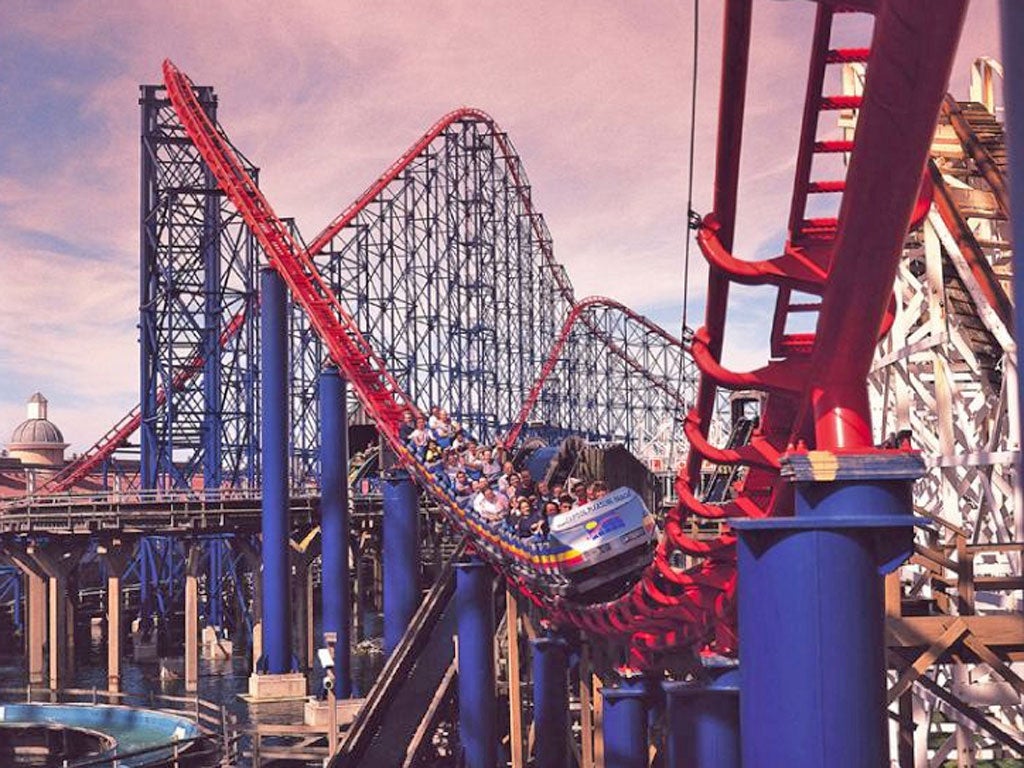The rollercoaster index
It's not just about height and speed – big rides can say a lot about the places they're built in. Chris Beanland discovers how ambitious new theme parks reflect economic ups and downs

Your support helps us to tell the story
From reproductive rights to climate change to Big Tech, The Independent is on the ground when the story is developing. Whether it's investigating the financials of Elon Musk's pro-Trump PAC or producing our latest documentary, 'The A Word', which shines a light on the American women fighting for reproductive rights, we know how important it is to parse out the facts from the messaging.
At such a critical moment in US history, we need reporters on the ground. Your donation allows us to keep sending journalists to speak to both sides of the story.
The Independent is trusted by Americans across the entire political spectrum. And unlike many other quality news outlets, we choose not to lock Americans out of our reporting and analysis with paywalls. We believe quality journalism should be available to everyone, paid for by those who can afford it.
Your support makes all the difference.The unmistakable sight of a helical steel track streaking across the horizon, combined with a soundtrack of whooshes and screams, makes your heart quicken. If you think back to the fondest memories of childhood, the chances are rollercoasters are writ large in them.
Remember when Jim fixed it for Sutton St Mary's Cub Scouts to eat their lunch on Blackpool's Revolution? But rollercoasters don't just offer base thrills to kids (and big kids). They are stark statements of intent; unwitting symbols of a country's ambitions and economic prowess.
The United States has been at the peak of the rollercoaster game since Disneyland opened outside Los Angeles in 1955. The ever-increasing size, speed and spread of US rollercoasters in the latter half of the 20th century asserted the primacy of American pleasure in the same way as the skyscrapers of Manhattan asserted the primacy of American capital in the first half of that century. Now the world's most famous architects build theme parks: Frank Gehry designed Disneyland's back offices. Rollercoasters fetishise railways – their steel gigantism crows about the might of industrial society. The quest to build bigger, longer, faster coasters is constant. "Most record-breaking rollercoasters have been built in the US," Robert Coker, author of A Thrill Seeker's Guide to the Ultimate Scream Machines, says, "but Japan boasts several record-breakers, and China is building enormous coasters at a frantic pace."
This architecture of excitement is rising in the East. "The development of new coasters in emerging economies is significant," Robert Niles, editor of Themeparkinsider.com, says. "It shows these economies have developed a middle class to support discretionary tourism."
Colleen Mangone, from the International Association of Amusement Parks and Attractions, confirms that "the attractions industry is experiencing tremendous growth in Asia". Take the £23m Takabisha (high-flying car) that opened last year in Japan and boasts the world's steepest drop. In Abu Dhabi, the new Ferrari World has the world's fastest rollercoaster.
"Rollercoasters provide a stream of services, a stream of thrills. Naturally we would expect the Bric (Brazil, Russia, India, China) economies to show a relatively high current rate of investment in the 'thrill industry', compared with early industrialisers such as the US," says the economist Shane Bonetti, a former St Andrews University academic who now advises the Australian government. "Investment in rollercoasters isn't a measure of the robustness or health of an economy – it's an index of the economic maturity the Brics are approaching."
Robert Niles adds: "The challenge will be to keep investing in these new world parks so that locals keep coming and don't save up to go to Florida instead." These days, Orlando airport rings with excited children speaking Russian, Chinese and Brazilian Portuguese. The city has built an entire economy around rollercoasters. This is the first taste of the country many people get. For those kids theme parks are America – and America is a theme park. Rollercoaster development was pioneered in the US – this is a country in thrall to them.
Perhaps surprisingly, austerity America is still building new ones – 20 this year. "2012 is a blockbuster year for new coasters in the US," Mangone says. At 7,160ft, the world's highest, Cliffhanger, has opened at Glenwood Caverns, Colorado. "It's a great combination of thrills and the views," the park's Mandy Gauldin says. "You see the Colorado River way down there."
Globally, theme parks are a £15bn industry. Switzerland is home to the greatest designers: Intamin and Bolliger & Mabillard. Britain's contribution to the coaster canon is modest. Yet rollercoasters have infected our psyche. We build them over our country estates: if you'd told the 16th Earl of Shrewsbury that his brooding gothic revival pile, Alton Towers, would become synonymous with rollercoasters, he and its pious architect, Augustus Pugin, might have choked on their roast snipe.
Our enthusiasm for ever more thrilling rides seems undiminished. Might these rides come to define the point where capitalist countries stop building for money, and start building for fun? As Bonetti says: "It's a delicious irony that something so apparently childish as rollercoasters are a symbol of economic maturity."
Join our commenting forum
Join thought-provoking conversations, follow other Independent readers and see their replies
Comments